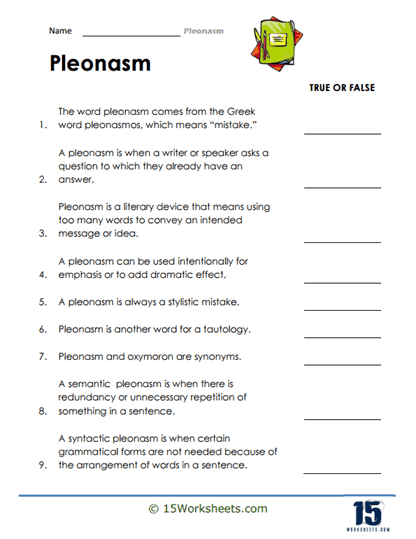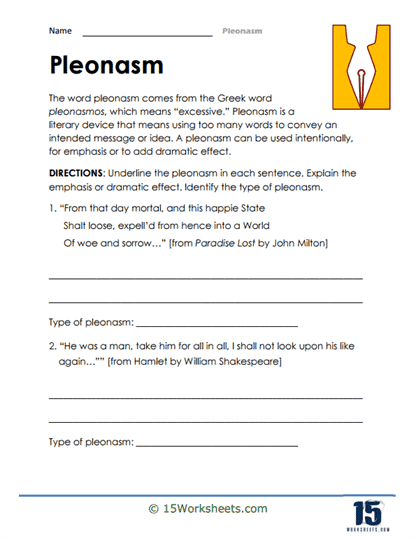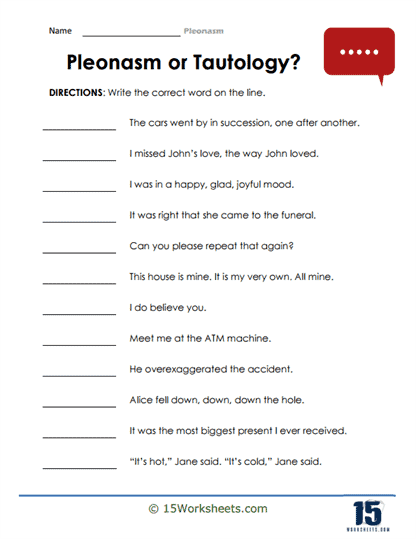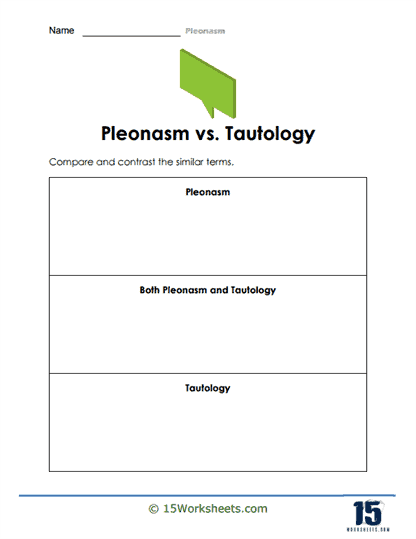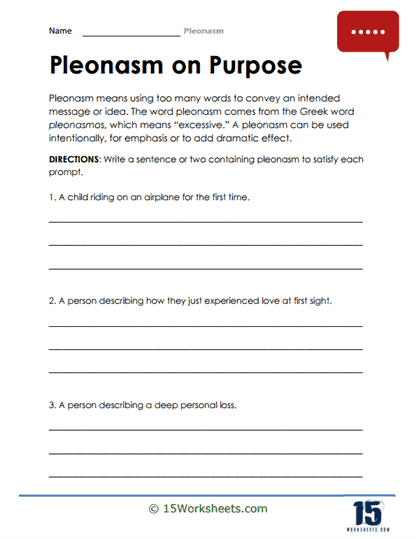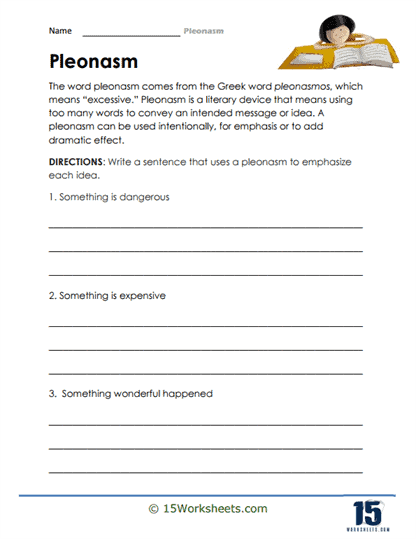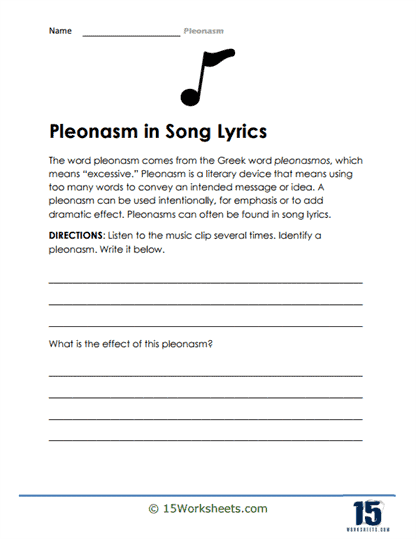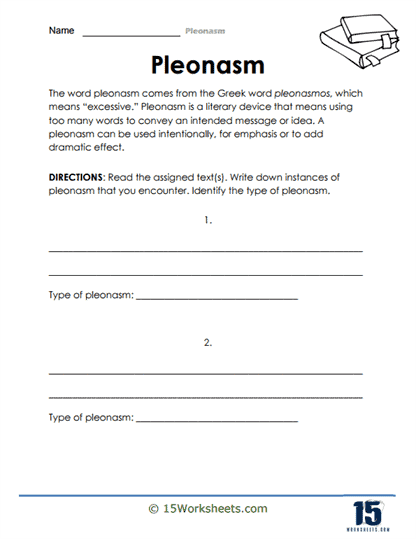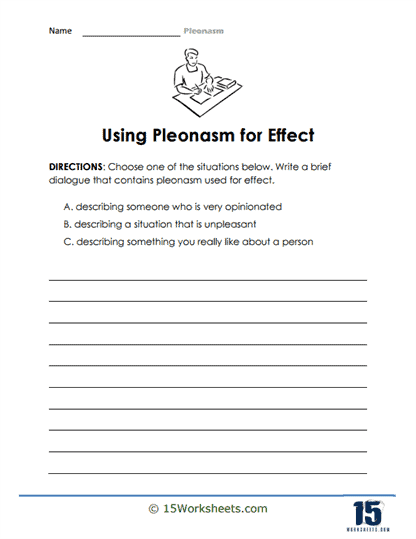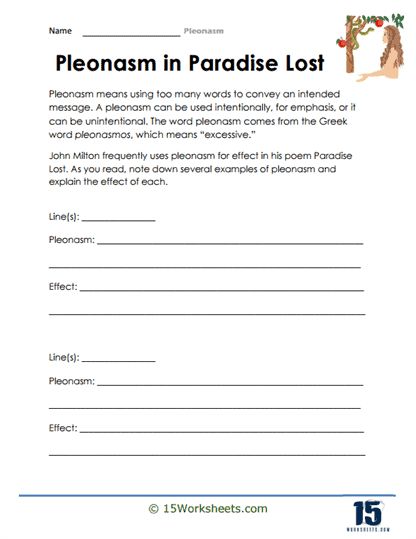Pleonasm Worksheets
About These 15 Worksheets
Pleonasm worksheets serve as an educational tool designed to sharpen students’ language arts and reading skills by focusing on the identification and elimination of pleonasms in writing. A pleonasm is a rhetorical figure involving the use of more words than necessary to convey meaning, either as a fault of style or for emphasis. Examples include phrases like “free gift” or “advance warning,” where one word is redundant because its meaning is already covered by another word in the phrase. These worksheets are crafted to help learners recognize redundant expressions in language, encouraging more precise and effective communication.
By engaging with these worksheets, students not only learn to eliminate unnecessary words from their writing but also gain a deeper understanding of the power of concise expression. This understanding is crucial across all forms of communication, from academic writing to everyday conversation, making pleonasm worksheets an invaluable tool in the development of language arts and reading skills. Through the various exercises they offer, students enhance their vocabulary, improve their writing clarity, and develop critical thinking skills. Ultimately, the practice with pleonasm worksheets empowers students to communicate more effectively, making them more articulate speakers and writers in any context.
Types of Exercises
Pleonasm worksheets feature a variety of exercises tailored to different learning levels and objectives. Here’s a comprehensive look at the types of exercises you might find:
Identification – These exercises present students with sentences filled with pleonasms. The task is to identify and underline or highlight the redundant words or phrases. This exercise helps in honing the ability to detect unnecessary repetition in text.
Correction – Following identification, correction exercises challenge students to rewrite sentences or phrases by eliminating the pleonasm. This activity promotes understanding of how to convey messages more succinctly.
Matching – Students match pleonastic phrases with their streamlined versions. This type of exercise aids in reinforcing the recognition of pleonasms and understanding their more concise alternatives.
Creating Thoughts – More advanced worksheets may ask students to create their own sentences that include pleonasms, and then revise them. This encourages creativity while practicing concise writing.
Multiple Choice Questions (MCQs) – These quizzes test students’ ability to pick out sentences either with or without pleonasms from a set of options, reinforcing their understanding through immediate feedback.
Fill-in-the-Blank – This exercise presents sentences with missing words, where students must choose the most concise option from a list to avoid pleonasm. It’s an effective way to practice precision in language use.
Comparative Analysis – Here, learners compare two versions of a text, one with pleonasms and one without, to analyze the impact of redundancy on clarity and effectiveness.
Peer Review – Students exchange papers to identify and suggest corrections for pleonasms in each other’s writing, fostering collaborative learning and critical thinking.
Benefits of These Worksheets
Practicing with pleonasm worksheets offers numerous benefits in improving students’ understanding of language arts and reading skills:
Enhanced Vocabulary – By identifying unnecessary words and finding more precise expressions, students expand their vocabulary and learn the nuances of word choice.
Improved Writing Clarity – Eliminating pleonasms leads to clearer, more direct writing. Students learn the importance of brevity, which is particularly valuable in academic and professional contexts.
Critical Thinking Skills – The process of detecting and correcting pleonasms requires analytical thinking, improving students’ ability to critique and refine their own writing and the writing of others.
Reading Comprehension – By working with complex sentences and distinguishing between essential and superfluous information, students enhance their reading comprehension skills.
Attention to Detail – These exercises cultivate a meticulous approach to language, encouraging students to pay closer attention to the details of word choice and sentence structure.
Creative Thinking – Creating sentences with and without pleonasms stimulates creativity, challenging students to think about how they can express ideas in multiple ways.
Awareness of Language Nuances – Through pleonasm worksheets, students gain an appreciation for the subtleties of language, understanding that how something is said is as important as what is said.
Preparation for Advanced Writing – Mastery of concise writing prepares students for more advanced tasks, such as essay writing, research papers, and creative writing, where clarity and precision are paramount.
What is the Literary Device of Pleonasm?
The literary device of pleonasm involves the deliberate use of more words than necessary to express an idea, either for emphasis or to enhance the narrative’s descriptive quality. Contrary to being merely redundant or verbose, pleonasm in literature is a stylistic choice that authors make to achieve specific effects, such as emphasizing a particular point, creating a rhythmic structure, or enriching the atmospheric detail of a narrative. This deliberate employment distinguishes pleonasm from inadvertent redundancy, elevating it from a potential flaw to a purposeful element of stylistic craftsmanship.
The Defining Feature of a Pleonasm
The primary defining feature of a pleonasm is the intentional use of additional words which, at face value, appear unnecessary because they restate information implied by other words in the same sentence or passage. However, within the realm of literary analysis, this “surplus” is not viewed as superfluous but as a means to add emphasis, depth, or clarity to the narrative or dialogue.
Characteristics of a Pleonasm
Redundancy for Emphasis – Pleonasms often include words or phrases that seem redundant but are used to emphasize a particular aspect of what is being said. This can make the statement more memorable or impactful.
Enhancement of Descriptive Quality – Authors use pleonasm to enrich descriptions, adding layers of detail that help paint a more vivid picture in the reader’s mind.
Contribution to Rhythmic and Poetic Quality – In poetry or prose, pleonasms can contribute to the work’s rhythm, enhancing its musicality or poetic nature.
Creation of a Specific Tone or Atmosphere – By using additional words, an author can slowly build up a specific tone or atmosphere, influencing the reader’s emotional response.
Characterization Tool – Pleonasm can be used in dialogue or narration to reveal character traits, such as a character’s verbosity, educational level, or cultural background.
Examples of Pleonasm in Literature
“Othello” by William Shakespeare
In Othello, Shakespeare uses pleonasm to add emotional depth and emphasis. For instance, when Othello exclaims, “Free and bounteous to her mind,” the use of both “free” and “bounteous” could be seen as pleonastic since both suggest generosity. However, Shakespeare’s choice to use both words adds to the intensity of Othello’s feelings and characterizes him as a deeply passionate and expressive individual.
“The Great Gatsby” by F. Scott Fitzgerald
Fitzgerald employs pleonasm to enhance the atmospheric and thematic elements of his narrative. A notable example is the description of Gatsby’s parties – “Every Friday five crates of oranges and lemons arrived from a fruiterer in New York—every Monday these same oranges and lemons left his back door in a pyramid of pulpless halves The detail “oranges and lemons” might be considered pleonastic since mentioning one could imply the other in the context of fruit. Yet, this repetition contributes to the opulence and extravagance of Gatsby’s lifestyle, emphasizing the wastefulness and excess that define the novel’s critique of the American Dream.
“Moby-Dick” by Herman Melville
Melville uses pleonasm to create a richly detailed and immersive world. An example of pleonasm in Moby-Dick can be found in Melville’s extensive descriptions of whaling. For instance, “the pathless, mysterious ocean” employs what could be seen as a pleonasm since “pathless” and “mysterious” both suggest the unknowable or uncharted nature of the sea. However, this redundancy serves to deepen the reader’s understanding of the ocean’s vast and enigmatic character, echoing the novel’s themes of obsession, the unknown, and man’s insignificance against nature.
Effect of Pleonasm on the Reader
The use of pleonasm in literature can have a profound impact on the reader, influencing both their emotional response and their engagement with the text:
Enhanced Emotional Impact – By emphasizing certain ideas or descriptions, pleonasm can make the narrative more compelling and emotionally resonant, drawing the reader deeper into the story.
Increased Memorability – The redundancy inherent in pleonasm can make phrases or passages more memorable, ensuring that certain elements of the story or its themes stick with the reader long after they have finished reading.
Greater Descriptive Depth – Pleonasm allows authors to build up a rich tapestry of detail, making the world of the story more vivid and immersive for the reader.
Rhythmic and Poetic Pleasure – The addition of extra words can enhance the rhythmic quality of the prose or poetry, providing a more enjoyable reading experience through its musicality.
Reflective Engagement – By signaling an author’s deliberate choice to use more words than necessary, pleonasm can prompt readers to reflect on why these choices were made, engaging them in a deeper level of analysis and appreciation for the craft of writing.





